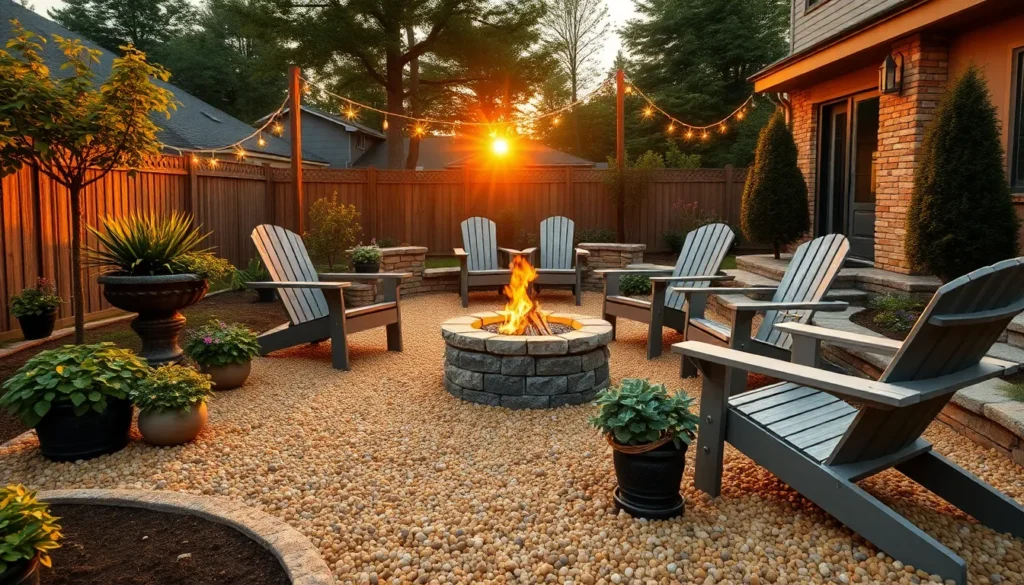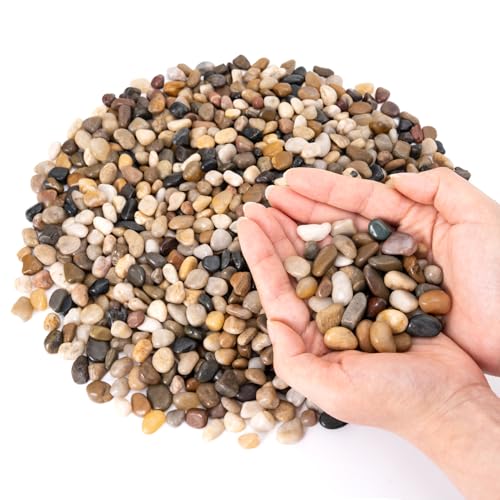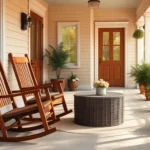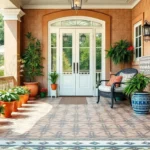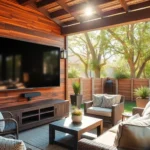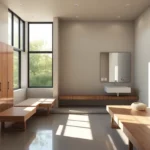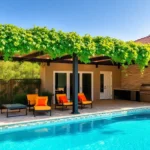We’ve all dreamed of creating that perfect outdoor oasis where we can unwind after long days and entertain friends on warm summer evenings. Pea gravel patios offer an incredibly versatile and budget-friendly solution that’s taking the landscaping industry by storm. These small rounded stones create stunning outdoor spaces that blend seamlessly with any architectural style while requiring minimal maintenance.
What makes pea gravel so appealing? It’s affordable, easy to install, and provides excellent drainage – making it ideal for areas that experience heavy rainfall. Plus, we can customize our pea gravel patio with different colors, borders, and design elements to match our unique vision.
Whether we’re working with a compact urban backyard or sprawling suburban industry, pea gravel patios adapt to any size or shape. From cozy reading nooks to expansive entertaining areas, these versatile spaces deliver both functionality and aesthetic appeal without breaking the budget.
Create a Simple Pea Gravel Base Patio
Building a pea gravel base patio offers the perfect foundation for your outdoor space transformation. We’ll walk you through the essential steps to create a durable and attractive patio that complements your home’s architecture.
Choose the Right Pea Gravel Size and Color
Selecting the appropriate pea gravel size ensures optimal comfort and functionality for your patio space. We recommend using 3/8-inch pea gravel as it provides the best balance between stability and walking comfort. Smaller sizes like 1/4-inch tend to stick to shoes and scatter easily, while larger 1/2-inch stones can feel uncomfortable underfoot.
Color selection significantly impacts your patio’s overall aesthetic appeal. Neutral tones such as buff, tan, and gray blend seamlessly with most home exteriors and landscaping designs. Earth tones like brown and rust complement traditional and rustic architectural styles beautifully. Lighter colors including white and cream create a bright, modern appearance that reflects heat effectively in sunny climates.
Consider your regional climate when making color choices. Light colored pea gravel stays cooler in hot weather, making it more comfortable for bare feet during summer months. Darker shades absorb more heat but provide rich visual contrast against green vegetation and colorful plantings.
Install Proper Edging Materials
Edging materials prevent pea gravel from spreading into surrounding industry areas and maintain clean patio boundaries. We suggest using steel edging for its durability and sleek appearance that works well with contemporary design styles. Aluminum edging offers lightweight installation benefits while providing excellent longevity against weather elements.
Natural stone edging creates beautiful transitions between your pea gravel patio and garden beds. Flagstone, limestone, and sandstone strips provide substantial barriers that complement rustic and traditional home styles effectively. These materials typically require deeper installation but deliver long lasting performance.
Plastic edging serves as an economical option for budget conscious projects. Heavy duty industry edging plastic maintains pea gravel boundaries effectively when properly installed with stakes every 2-3 feet. This material works particularly well for curved patio designs where flexibility becomes essential.
Installation depth matters significantly for edging effectiveness. We recommend setting edging materials at least 4-6 inches deep to prevent gravel migration and ensure structural stability over time.
Add Industry Fabric for Weed Prevention
Industry fabric creates an essential barrier that prevents weeds from growing through your pea gravel patio surface. We recommend using commercial grade woven industry fabric rather than plastic sheeting, as it allows proper water drainage while blocking unwanted plant growth effectively.
Proper fabric installation requires overlapping seams by at least 6 inches to eliminate gaps where weeds might penetrate. Secure the fabric using industry staples every 12-18 inches along edges and seams for maximum stability. This spacing prevents fabric movement during gravel installation and seasonal weather changes.
Quality fabric selection impacts long term maintenance requirements. Heavy duty polypropylene fabrics resist tearing and provide superior weed blocking capabilities compared to lighter weight alternatives. Professional grade fabrics typically last 10-15 years before requiring replacement, making them cost effective investments.
Water permeability remains crucial for proper drainage beneath your pea gravel patio. We always verify that industry fabric allows water penetration by conducting simple water tests before installation. Fabrics that retain water can create drainage issues and potentially damage your patio’s foundation over time.
Design a Pea Gravel Patio with Stepping Stones
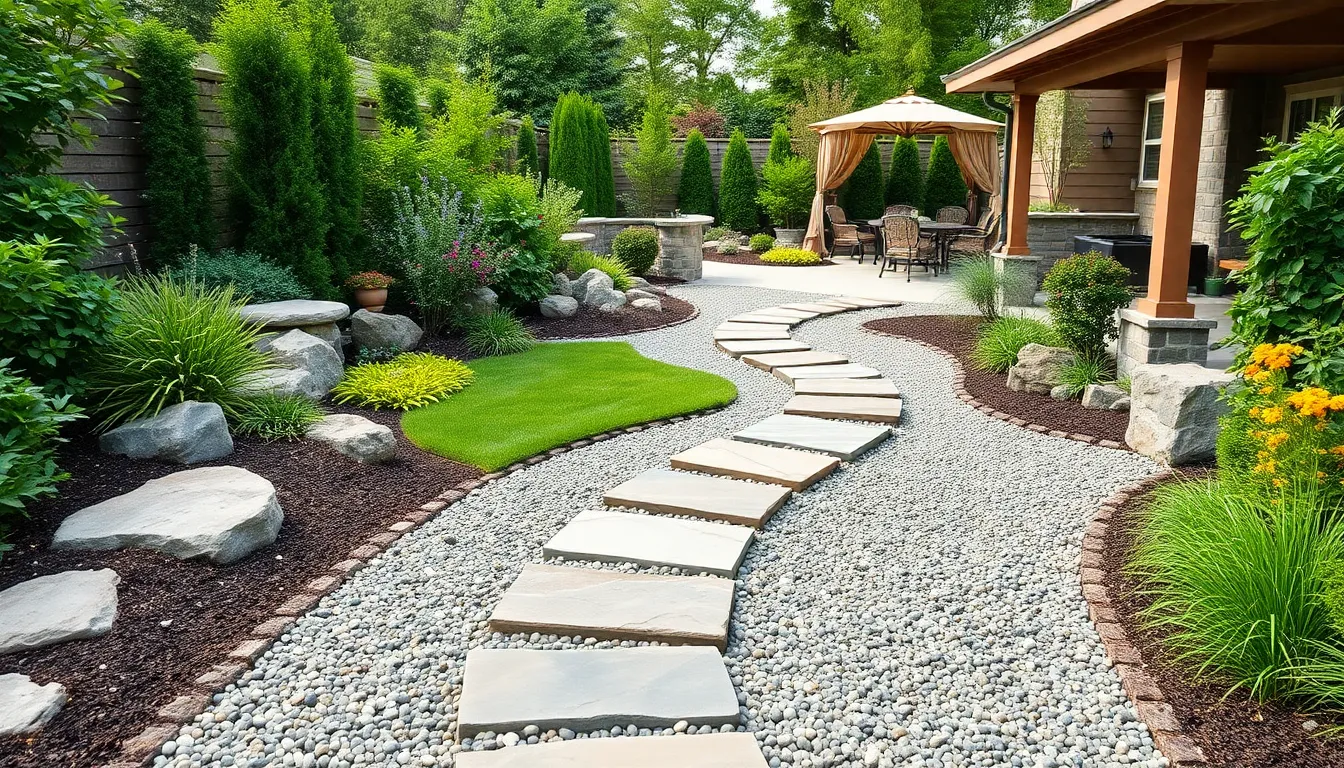
Incorporating stepping stones into your pea gravel patio creates visual interest while providing functional pathways through the loose gravel surface. This design approach transforms a simple gravel area into a structured outdoor space that balances natural texture with purposeful navigation.
Select Natural Stone or Concrete Pavers
Natural stones like flagstone or slate deliver an organic, rustic feel that complements the casual character of pea gravel. We recommend choosing stones that match your home’s exterior style and existing garden elements for a cohesive look. Concrete pavers offer uniformity and modern aesthetics, making them perfect for contemporary outdoor designs.
Stone selection impacts both durability and visual appeal in your patio design. Flagstone works exceptionally well because its irregular shapes create natural stepping patterns that feel organic within the gravel. Slate provides a sophisticated surface that contrasts beautifully with the rounded texture of pea gravel stones.
Concrete pavers give you consistent sizing and color options that work well in geometric layouts. These manufactured stones maintain their appearance longer than natural materials and offer predictable installation patterns. Consider the thickness of your chosen stones to ensure they sit properly above the gravel surface.
Create Attractive Pathways Through the Gravel
Setting pathways within your pea gravel using stepping stones establishes clear navigation routes while maintaining the natural look of your outdoor space. We suggest designing walkways that lead to exact destinations like seating areas, garden features, or outdoor zones to create purposeful flow.
Straight line patterns work well for formal patio designs and direct traffic efficiently between key areas. Gentle curves feel more natural and soften the overall appearance of your patio space. Consider your patio’s shape and existing industry features when planning pathway routes.
Multiple pathways can connect different sections of larger patios, creating distinct zones for dining, relaxation, or entertainment. These stone routes break up the uniform texture of pea gravel while providing stable walking surfaces. Design pathways wide enough for comfortable passage, typically allowing space for single file walking.
Maintain Proper Spacing Between Stones
Spacing stepping stones about 18 to 24 inches apart accommodates average stride length and creates comfortable walking experiences. We’ve found that stones placed too close create a crowded appearance, while excessive spacing makes navigation awkward and uncomfortable.
Two foot spacing typically works well for most adults and maintains visual appeal throughout your patio design. This distance allows the pea gravel to show between stones while providing secure footing for users. Consider the primary users of your patio when determining final spacing measurements.
Test your stone spacing by walking the intended path before finalizing placement. Adjust distances based on natural stride patterns and ensure consistent spacing throughout each pathway. Mark stone positions with temporary markers to visualize the complete layout before permanent installation.
Build a Pea Gravel Patio with Fire Pit Area
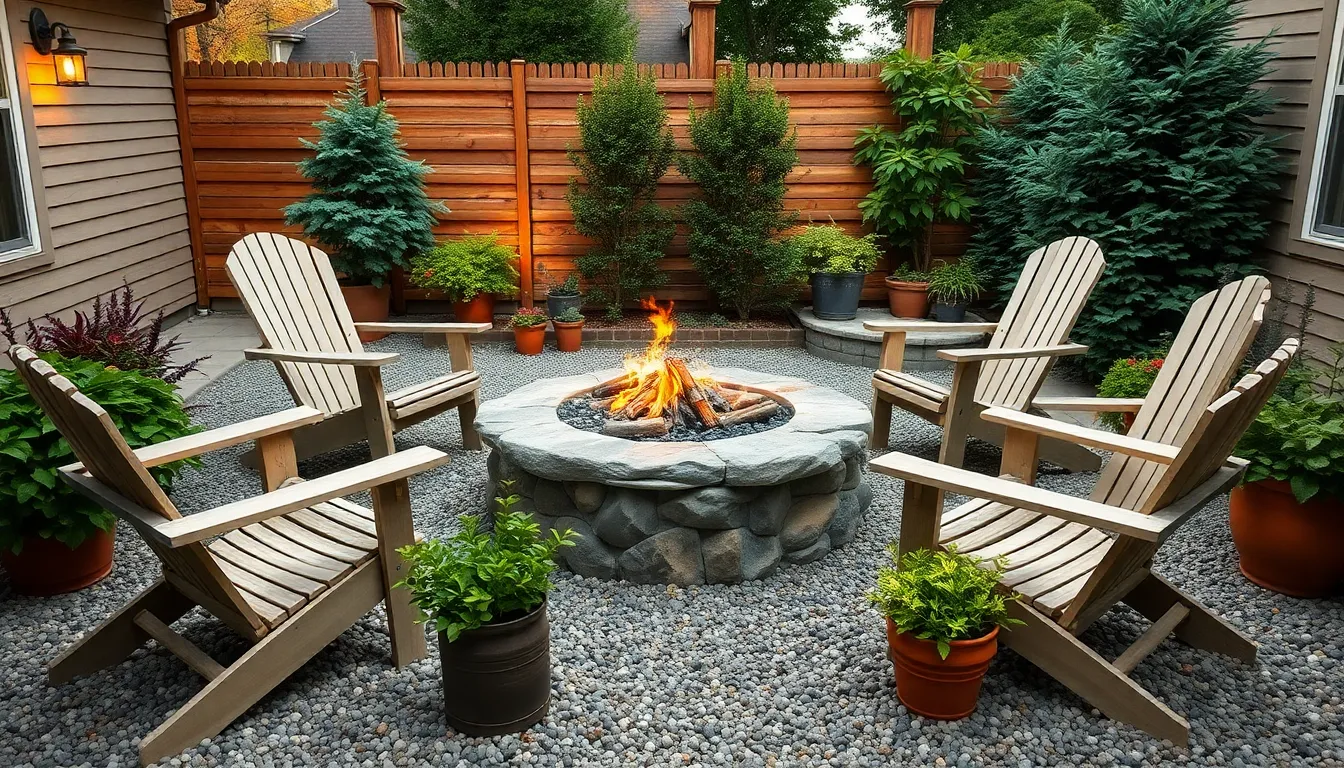
Creating a fire pit area within your pea gravel patio transforms the space into a cozy gathering spot perfect for year-round entertaining. We’ll guide you through the essential elements that make this combination both functional and visually stunning.
Design a Central Fire Feature
Positioning your fire pit as the focal point creates natural flow and conversation areas throughout your pea gravel space. We recommend placing stone or metal fire pits centrally or slightly off-center to establish an inviting gathering atmosphere. Stone fire pits blend seamlessly with pea gravel’s rustic aesthetic, while metal options offer modern contrast against the natural texture.
Surrounding pea gravel complements fire elements beautifully, creating elegant transitions between hardscape and flame. We suggest maintaining consistent gravel depth around the fire feature to ensure stable placement and easy maintenance. Circular or square fire pit shapes work equally well with pea gravel’s organic flow, allowing flexibility in your overall design approach.
Create Seating Areas Around the Fire Pit
Arranging weather-resistant seating around your fire feature maximizes both comfort and functionality within the gravel space. We recommend Adirondack chairs, wooden benches, or built-in stone seats that complement your patio’s natural materials. Pea gravel’s excellent drainage properties provide firm, stable bases for moveable furniture pieces.
Flexible placement becomes effortless with gravel surfaces, allowing seasonal adjustments or special event configurations. We enhance comfort by adding weather-resistant cushions, portable side tables, and strategically placed potted plants around seating zones. Multiple seating arrangements accommodate different group sizes while maintaining clear pathways between furniture pieces.
Ensure Proper Fire Safety Considerations
Maintaining adequate clearance between fire pits and flammable materials protects both property and guests during outdoor gatherings. We recommend keeping minimum distances of 10 feet from structures, overhanging branches, and combustible landscaping elements. Non-combustible edging materials like steel or stone provide additional safety barriers around the fire zone.
Fire extinguishers or water buckets should remain easily accessible near every fire pit installation. We advise checking local fire codes and obtaining necessary permits before constructing permanent fire features. Regular maintenance includes clearing debris from around fire areas and inspecting equipment for damage or wear.
Incorporate Built-In Planters and Garden Beds
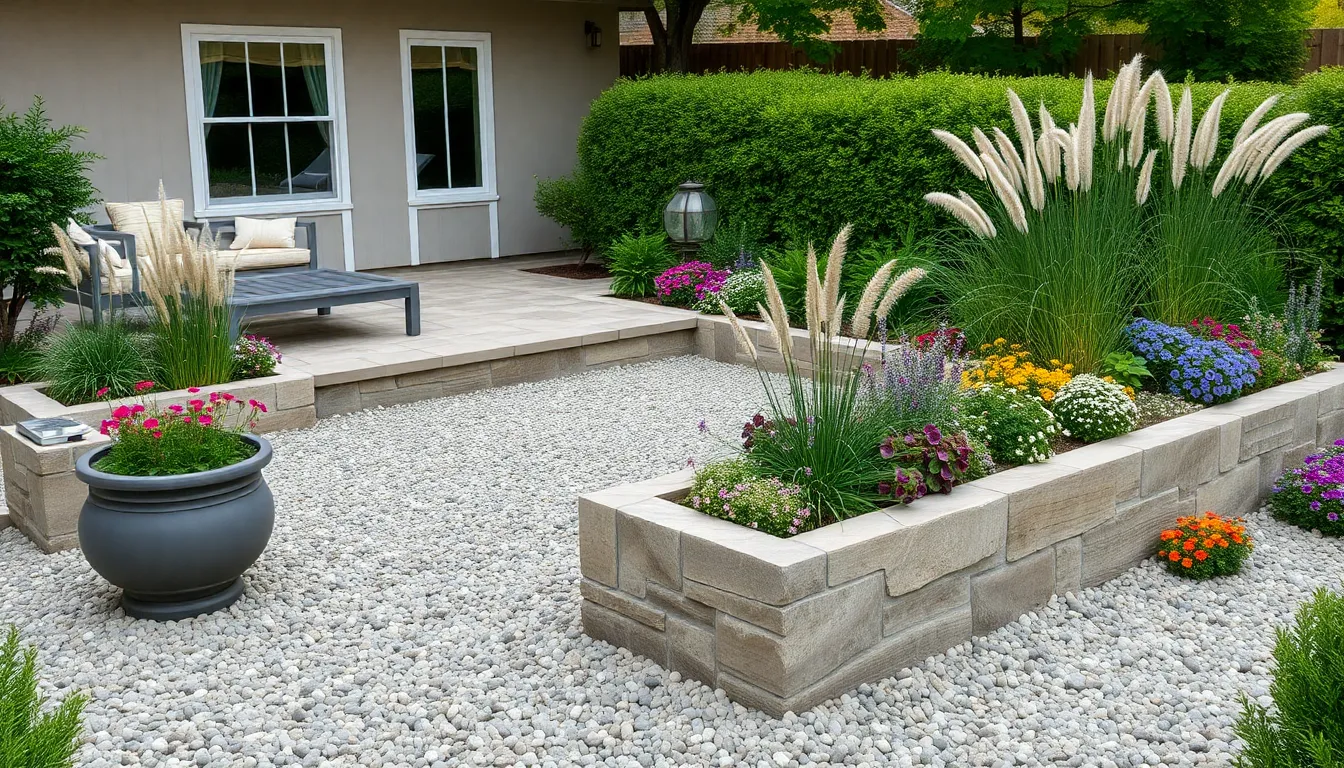
Built-in planters transform your pea gravel patio from a simple hardscape into a living outdoor space that seamlessly blends function with natural beauty. Integrating garden beds directly into your patio design creates defined growing zones while maintaining the cohesive aesthetic you’ve established with your gravel surface.
Design Raised Planter Boxes
Raised planter boxes offer superior soil drainage and easier maintenance compared to ground-level plantings, making them perfect companions for pea gravel patios. Wood, stone, and metal materials work exceptionally well for constructing these elevated garden features that contrast beautifully with the loose texture of your gravel surface.
Position your planter boxes strategically around or within the patio boundaries to create visual anchor points that break up the expanse of gravel. Elevated designs provide comfortable access for planting and weeding while offering better soil quality control than native ground conditions. Strategic placement allows you to frame seating areas or create natural room dividers within your outdoor space.
Flush-mounted planters that sit level with your patio surface create seamless transitions between hardscape and softscape elements. Slightly elevated boxes add dimensional interest while maintaining easy navigation around your outdoor living area. Consider varying heights and sizes to create ever-changing visual compositions that enhance your patio’s overall design flow.
Choose Plants That Complement Pea Gravel
Drought-tolerant perennials thrive in the well-draining environment that pea gravel patios naturally provide, making them ideal choices for your integrated garden beds. Ornamental grasses like fountain grass and blue fescue add movement and texture while requiring minimal water once established. Succulents such as sedum varieties and hens-and-chicks create striking focal points with their architectural forms and seasonal color changes.
Low-growing ground covers soften the edges where your planters meet the gravel surface, creating natural transitions that integrate your patio into the surrounding industry. Mediterranean herbs including lavender, rosemary, and thyme not only complement the gravel aesthetic but also provide fragrance and culinary benefits. Native wildflowers adapted to your region offer seasonal color while supporting local wildlife and requiring less maintenance than exotic species.
Consider plant heights and growth patterns when selecting varieties to ensure your choices won’t overwhelm the clean lines of your pea gravel design. Clumping plants rather than spreading varieties help maintain defined boundaries between your planted areas and gravel surfaces.
Create Natural Borders with Greenery
Natural plant borders provide organic boundaries that frame your pea gravel patio while creating privacy and visual interest without requiring hard edging materials. Hedge plants like boxwood or native shrubs establish clear perimeters while blending your patio seamlessly into the garden environment. Clusters of perennial plants create softer, more naturalistic borders that change with the seasons.
Vertical elements from taller shrubs and ornamental trees add dimension to your patio space while providing natural windbreaks and privacy screens. Strategic groupings of plants at varying heights create layered borders that enhance the overall aesthetic appeal of your outdoor area. Consider evergreen options for year-round structure and deciduous plants for seasonal interest and change.
Border plantings help contain your pea gravel naturally while providing habitat for beneficial insects and birds that enhance your outdoor experience. Choose plants with different blooming periods to ensure continuous color and interest throughout the growing season, making your patio an ever-changing focal point in your industry design.
Add Outdoor Furniture and Dining Areas
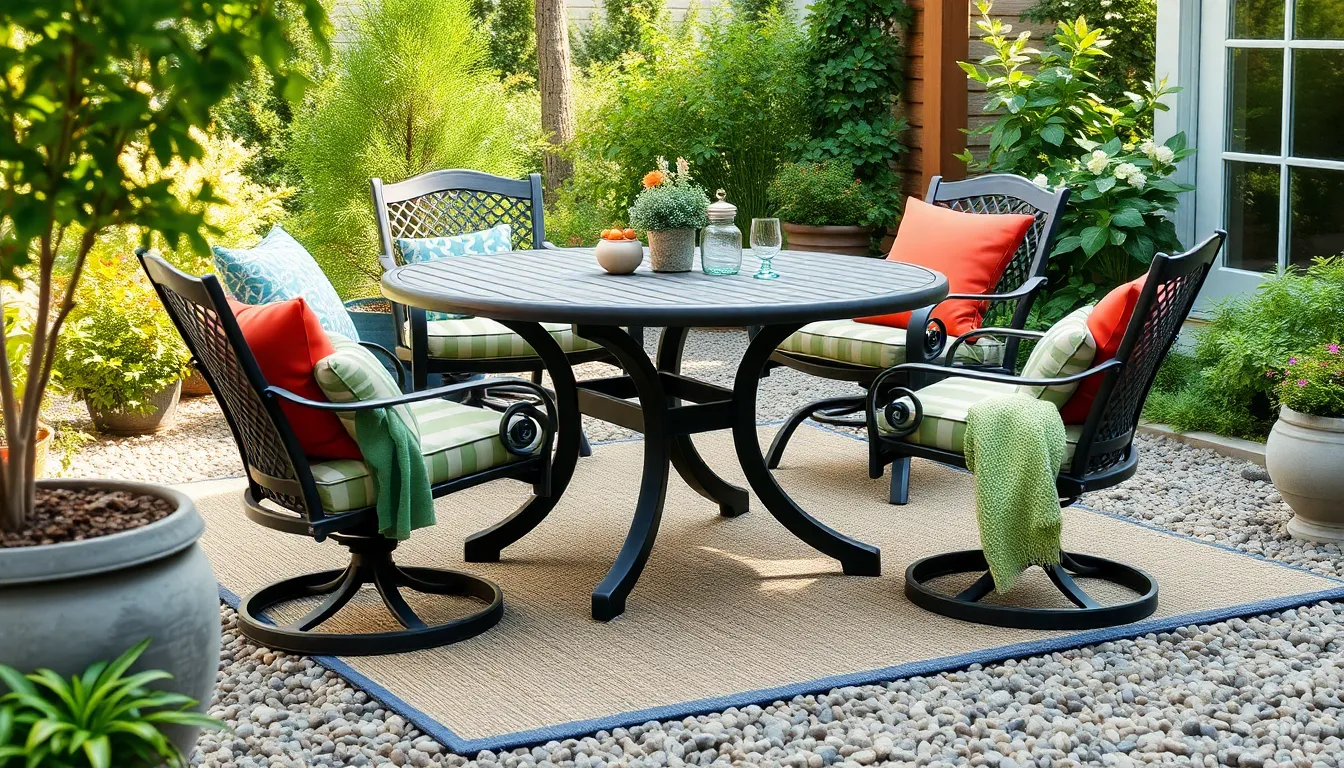
Transform your pea gravel patio into an inviting outdoor living space by incorporating functional furniture and dining elements that complement the natural aesthetic you’ve already established.
Select Weather-Resistant Patio Furniture
Materials make all the difference when choosing furniture for your pea gravel patio. Metal furniture options like aluminum and powder-coated steel resist rust and corrosion while maintaining their appearance through years of exposure to sun, rain, and humidity. Treated wood furniture brings warmth to your gravel setting and develops a beautiful patina over time when properly maintained with seasonal applications of protective sealers.
Synthetic wicker furniture offers the classic look of natural materials without the maintenance concerns. These pieces resist fading, cracking, and moisture damage while providing comfortable seating that pairs beautifully with the organic texture of pea gravel. Teak furniture represents a premium option that naturally weathers to an elegant silver-gray finish and can last decades with minimal care.
Weight becomes crucial when selecting pieces for gravel surfaces. Heavier furniture stays put during wind and provides better stability on the shifting surface of pea gravel. Consider dining sets with substantial table bases and chairs with wider legs that distribute weight more evenly across the gravel.
Create Stable Furniture Pads
Furniture pads prevent your pieces from sinking into the gravel while maintaining level surfaces for comfortable dining and relaxation. Pavers placed strategically under table and chair legs create solid foundations that distribute weight effectively across the gravel surface. Choose pavers that complement your patio’s color scheme while providing the structural support your furniture needs.
Wooden boards offer another excellent option for creating stable furniture bases. Cedar and pressure-treated lumber resist moisture and insects while blending naturally with outdoor environments. Cut boards slightly larger than furniture footprints to ensure adequate support and prevent gravel from shifting around the edges.
Rubber furniture pads designed for outdoor use provide excellent grip on both furniture legs and gravel surfaces. These flexible options conform to slight variations in gravel height while protecting furniture finishes from direct contact with stone. Look for UV-resistant rubber that won’t degrade under constant sun exposure.
Interlocking deck tiles create larger stable areas perfect for dining sets or conversation groups. These modular systems snap together to form custom-sized platforms that sit securely on gravel while providing level surfaces for furniture placement.
Design Comfortable Seating Arrangements
Conversational clusters work exceptionally well on pea gravel patios where you can easily adjust furniture placement to take advantage of views and natural focal points. Position seating to face your garden’s most attractive features or create intimate conversation areas around your fire pit. This flexibility allows you to adapt your space for different occasions and group sizes.
Flow patterns become essential when arranging furniture on gravel surfaces. Leave adequate pathways between seating areas to accommodate foot traffic without disturbing gravel or creating worn paths. Consider how guests will move through your space and position furniture to encourage natural circulation.
Cushioned seating enhances comfort while adding color and softness to the textural contrast of pea gravel. Choose outdoor cushions with quick-dry foam and fade-resistant fabrics that complement your patio’s natural palette. Store cushions during harsh weather to extend their lifespan and maintain their appearance.
Outdoor rugs designed for gravel surfaces create defined seating areas while providing softer footing around chairs and tables. These specialized rugs allow water drainage while staying put on loose gravel surfaces. Select patterns and colors that coordinate with your furniture while adding visual interest to your patio design.
Install Decorative Lighting Features
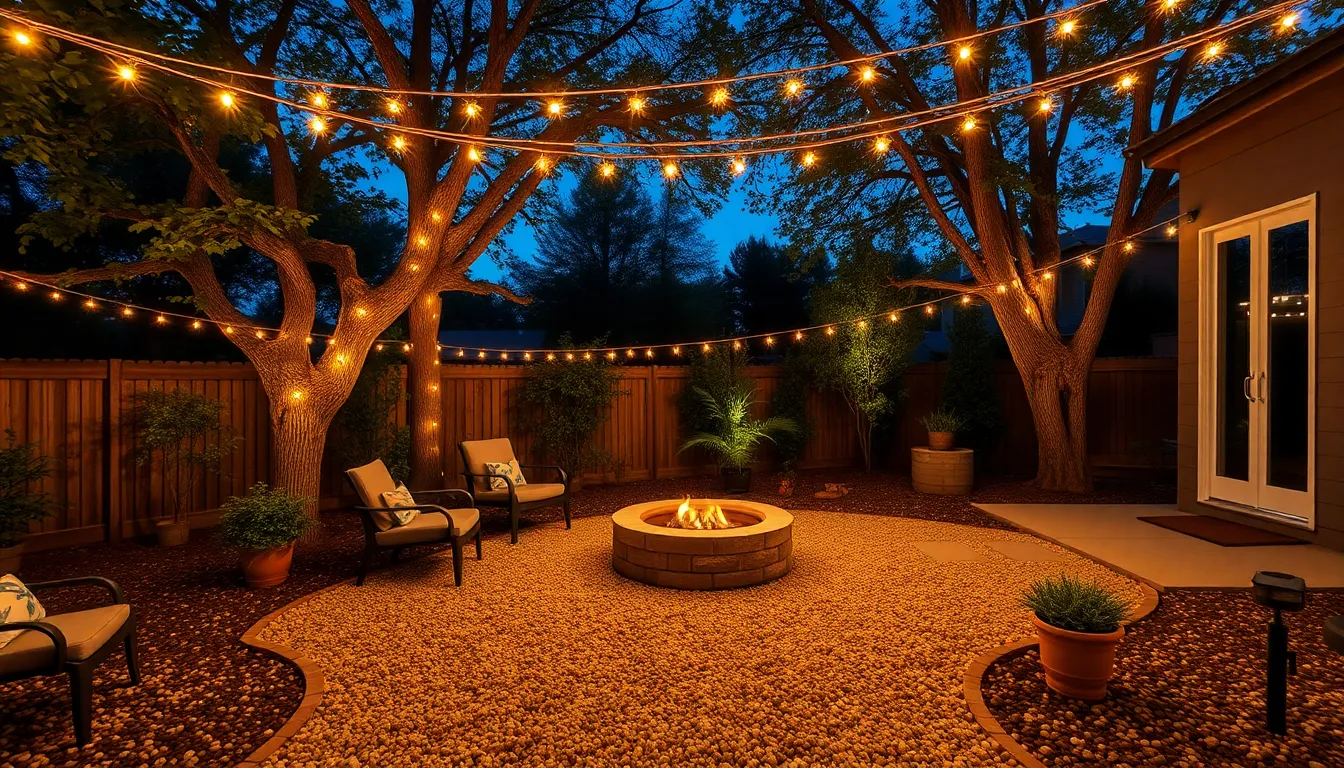
Decorative lighting transforms your pea gravel patio into a captivating evening retreat while extending its usability after sunset. Strategic lighting placement enhances both safety and ambiance across your outdoor space.
Add String Lights for Ambient Lighting
String lights create the most popular lighting solution for pea gravel patios, delivering warm illumination that makes outdoor spaces feel inviting and cozy. We recommend hanging them overhead between posts, trees, or pergola structures to cast gentle light across the gravel surface. Draping string lights along fence lines provides perimeter lighting that softens harsh edges and creates intimate boundaries.
Wrapping lights around nearby trees or posts adds vertical visual interest while complementing the rustic aesthetic of your pea gravel patio. Commercial grade outdoor string lights withstand weather conditions better than indoor varieties and offer longer lifespans for consistent performance. Installing dimmer switches allows you to adjust brightness levels based on different occasions, from intimate dinners to larger gatherings.
Install Solar Path Lights Along Edges
Solar powered path lights along your patio edges provide energy efficient illumination without requiring electrical wiring or increasing utility costs. These fixtures highlight the patio’s shape and boundaries while offering subtle guidance for guests handling the space after dark. Installing lights at 6 to 8 foot intervals creates consistent coverage without overwhelming the natural gravel texture.
Solar lights require direct sunlight during daytime hours to charge their batteries for nighttime operation, making them ideal for patios with good sun exposure. We suggest choosing models with warm LED bulbs that complement the earthy tones of pea gravel rather than harsh white lights. Stake mounted solar lights work best on gravel surfaces, allowing for easy repositioning as your patio design evolves.
Incorporate Industry Lighting for Safety
Low voltage industry lighting around your patio perimeter enhances safety by illuminating potential trip hazards like steps, elevation changes, or nearby garden beds. LED spotlights positioned strategically can accent architectural elements, mature trees, or decorative planters while providing functional illumination. Well lights installed flush with pathways leading to your patio create seamless safety lighting without disrupting the gravel’s natural appearance.
Installing industry lighting near seating areas and fire pit zones ensures guests can move safely between different patio sections during evening gatherings. Professional grade fixtures resist moisture and temperature fluctuations better than basic models, providing reliable performance across seasons. We recommend using warm color temperatures between 2700K and 3000K to maintain the cozy atmosphere that makes pea gravel patios so appealing for outdoor entertaining.
Create Multi-Level Pea Gravel Terraces
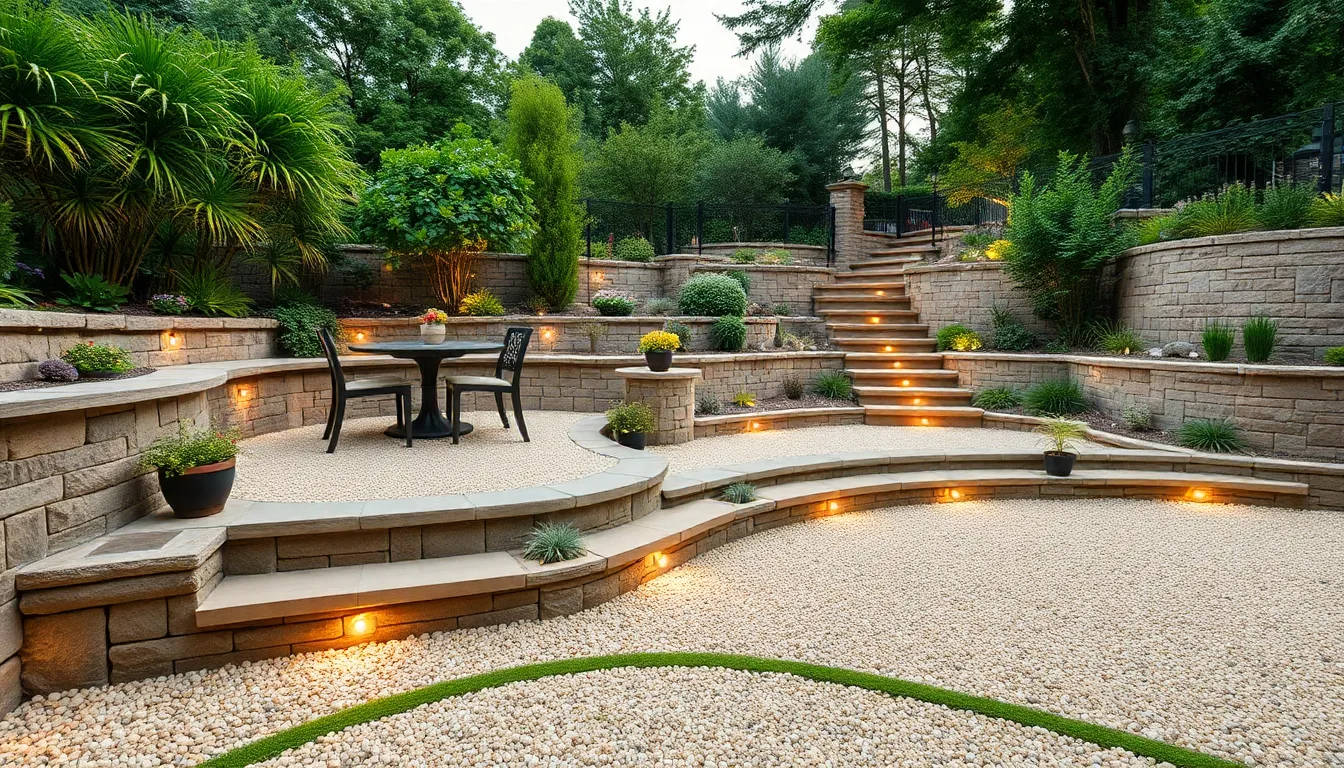
Transforming your pea gravel patio into distinct zones becomes achievable through terraced design that maximizes both function and visual appeal. We’ll explore how to create multiple levels that provide separate areas for dining, seating, and planting while maintaining the cohesive aesthetic of your outdoor space.
Design Retaining Walls for Different Levels
Retaining walls serve as the backbone of successful terraced pea gravel patios by holding materials in place and defining each level clearly. Natural stone walls create rustic charm while timber options offer warmth and accessibility for DIY installation. Concrete blocks provide durability and clean lines that complement modern outdoor designs.
We recommend building walls between 12 to 36 inches high to create comfortable level changes without overwhelming the space. These structures prevent gravel washout during heavy rains and maintain distinct boundaries between terrace zones. Strategic placement transforms retaining walls into functional seating ledges or display areas for potted plants.
Installation requires proper foundation preparation with compacted gravel base and adequate drainage behind the wall structure. Timber walls need treated lumber rated for ground contact while stone installations benefit from mortar joints for long term stability. Consider integrating lighting into wall caps to enhance evening ambiance and safety navigation between levels.
Plan Drainage Between Terrace Levels
Proper drainage prevents water pooling and erosion that can destabilize your multi level pea gravel terraces over time. We recommend grading each terrace surface with a slight slope away from structures and toward designated drainage points. French drains installed between levels capture excess water and direct it safely away from the patio area.
Gravel layers beneath the surface pea gravel create natural drainage channels that handle normal rainfall without compromising stability. Drainage pipes positioned behind retaining walls collect water that might otherwise build pressure and damage wall structures. We suggest using perforated pipes surrounded by clean gravel and covered with industry fabric.
Consider installing catch basins at the lowest terrace level to manage heavy water flow during storms. Surface drainage channels lined with decorative stone can become attractive features while serving essential water management functions. Regular maintenance includes clearing drainage outlets and checking for settling that might redirect water flow patterns.
Connect Levels with Steps or Ramps
Steps and ramps create safe comfortable transitions between terraced levels while improving the overall design flow of your pea gravel patio. Timber steps offer natural warmth and blend seamlessly with retaining wall materials for cohesive appearance. Stone steps provide durability and can incorporate the same materials used in your retaining walls.
We recommend step risers between 4 to 7 inches high with treads at least 12 inches deep for comfortable navigation. Concrete steps deliver clean modern lines and can be textured or colored to complement your pea gravel selection. Ramps provide accessibility options with gentle slopes that accommodate mobility devices and heavy furniture movement.
Strategic positioning of connectors maintains natural traffic flow and creates inviting pathways between functional zones. Consider incorporating landings at direction changes to provide rest areas and enhance safety during transitions. Lighting integration along step edges and ramp borders extends usability after sunset while adding sophisticated design elements to your multi level pea gravel terrace system.
Combine Pea Gravel with Other Hardscape Materials
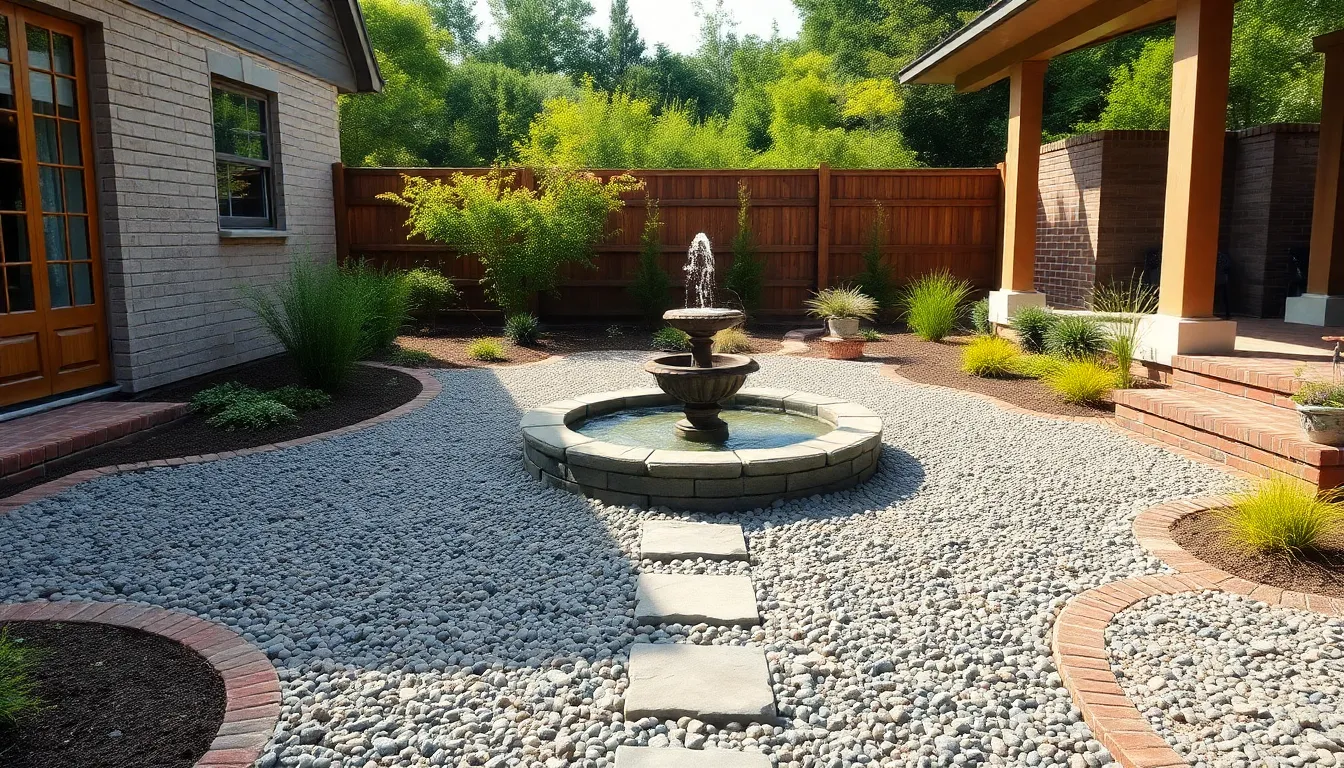
Mixing pea gravel with complementary hardscape materials creates visual depth and functional definition in your outdoor space. These combinations transform a simple gravel surface into a sophisticated patio design that balances natural textures with structural elements.
Mix with Flagstone or Brick Accents
Flagstone stepping stones embedded within pea gravel fields create an elegant pathway that guides guests through your patio space. Natural stone materials like flagstone provide the structural interest and refined aesthetic that elevates the rustic appeal of loose gravel. Brick insets work beautifully to form geometric patterns or define exact zones within the larger pea gravel area.
Consider creating a checkerboard pattern using square brick pavers alternated with gravel sections for a formal garden feel. Flagstone pieces can serve as natural gathering spots for outdoor furniture placement, giving you stable surfaces while maintaining the permeable benefits of gravel. These stone accents also add crucial color contrast that prevents the patio from appearing monotonous.
Border treatments using brick edging help contain the gravel while introducing warm terra cotta tones that complement earth-colored stones. This combination balances the permanence of masonry with the flexibility of loose aggregate materials.
Add Concrete or Wood Borders
Concrete borders provide the clean, finished edge that prevents pea gravel from migrating into adjacent lawn or garden areas. Poured concrete edging creates seamless transitions between different outdoor zones while offering a contemporary look that works with modern home styles. Prefabricated concrete pavers give you installation flexibility and can be arranged in straight lines or gentle curves.
Wood borders introduce natural warmth through materials like cedar or pressure-treated lumber that frame your patio perimeter beautifully. Timber edging creates distinct boundaries while allowing for seasonal adjustments as your industry evolves. These wooden frames can be built at various heights to accommodate sloped areas or create subtle level changes.
Both concrete and wood options help drainage by containing the gravel bed while allowing water to permeate through the aggregate. Professional installation ensures these borders remain stable over time and maintain their appearance through weather changes.
Integrate Water Features or Fountains
Water features surrounded by pea gravel beds create tranquil focal points that enhance the sensory experience of your outdoor space. Small fountains positioned within or adjacent to gravel areas provide soothing sounds while benefiting from the excellent drainage properties of the aggregate surface. The textural contrast between flowing water and rough gravel adds visual interest that draws attention to these special elements.
Pond installations work exceptionally well with pea gravel surrounds because the stones help easy drainage and simple maintenance access. Consider placing accent lighting near water features to create dramatic nighttime effects that highlight both the movement of water and the texture of surrounding gravel. These installations often require minimal excavation since the gravel base accommodates plumbing and electrical components easily.
Gravel paths leading to water features create natural circulation patterns that encourage exploration of your outdoor space. The combination of water, stone, and aggregate materials establishes a peaceful atmosphere perfect for relaxation and contemplation.
Maintain Your Pea Gravel Patio Year-Round
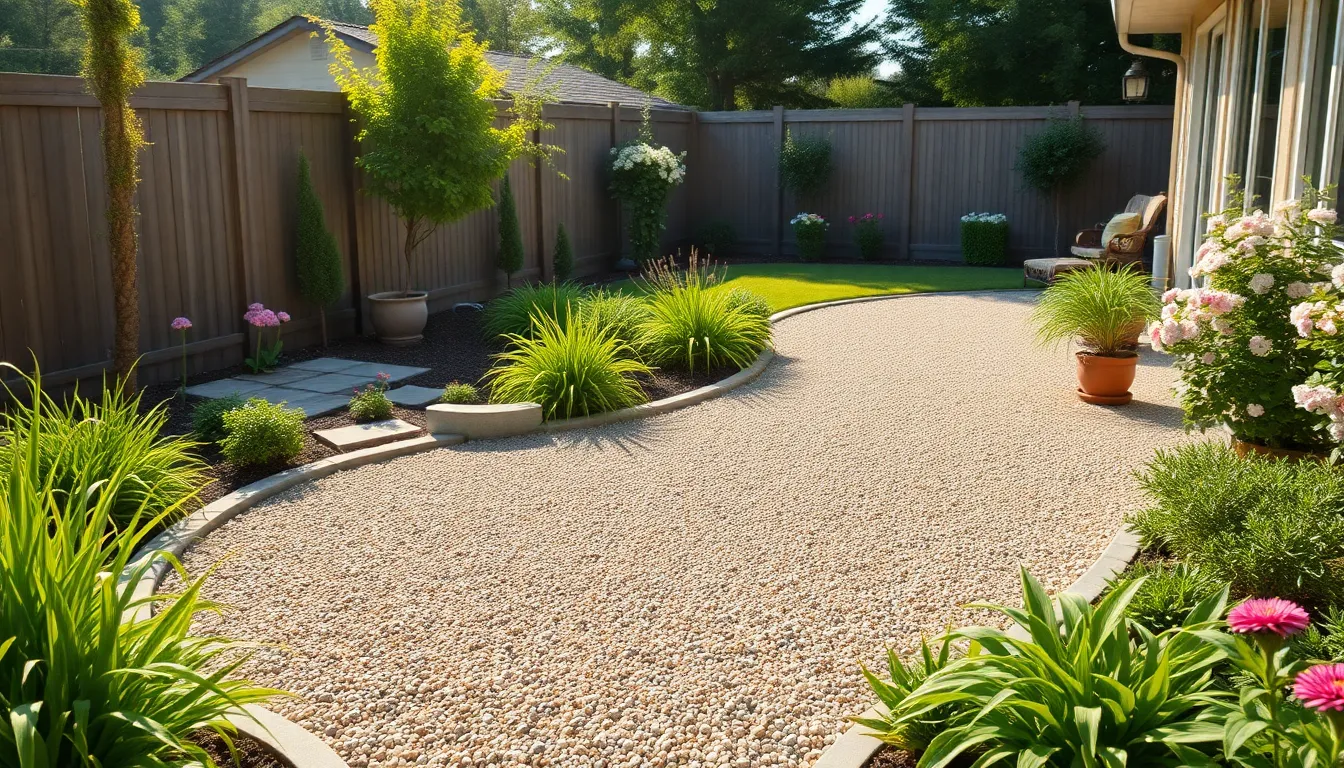
Once we’ve established our beautiful pea gravel patio with all its design elements, consistent maintenance keeps it looking pristine throughout every season.
Regular Raking and Leveling Techniques
Raking our pea gravel patio regularly prevents unsightly low spots and maintains an even surface. We recommend scheduling this task at the start of each season to redistribute stones that naturally settle in dips and valleys. Metal rakes work efficiently for this purpose, allowing us to drag gravel from accumulated areas back to thinner sections.
Maintaining a consistent two-inch depth across the entire patio ensures optimal comfort and visual appeal. We can use a industry rake to smooth larger areas quickly, creating uniform coverage that enhances both function and appearance. This simple maintenance step prevents gravel displacement and preserves the walking surface we’ve worked hard to create.
Leveling techniques become especially important after heavy rains or foot traffic. We should focus on high-traffic areas where stones tend to shift most frequently, using systematic back-and-forth motions to restore evenness.
Weed Control and Prevention Methods
Installing a high-quality permeable weed barrier beneath our gravel provides the most effective long-term prevention. We need this underlayer to block emerging weeds while maintaining proper water drainage throughout the patio system. Commercial-grade woven fabric offers superior durability compared to standard industry fabric options.
Edging materials like bricks or metal strips help contain our gravel and minimize weed migration from surrounding soil. We can create clean boundaries that prevent both gravel escape and unwanted plant intrusion. These barriers work alongside our weed fabric to form a comprehensive defense system.
Removing any weeds that do appear immediately prevents them from establishing root systems. We should combine this manual removal with pre-emergent weed control treatments applied according to manufacturer instructions. Regular inspection walks help us catch problem areas before they become major maintenance issues.
Seasonal Refreshing and Touch-Up Tips
Adding fresh pea gravel seasonally compensates for natural displacement and settling over time. We need to inspect our patio each season and identify areas where coverage has thinned due to weather or foot traffic. Purchasing matching gravel ensures seamless integration with our existing surface.
Cleaning our gravel with pressure washing or stiff brush scrubbing removes accumulated debris and restores its original appearance. We can use mild soap answers to tackle stubborn stains, followed by thorough rinsing to eliminate any residue. This process removes leaves, pine needles, and other organic matter that can dull the gravel’s color.
Tamping selected areas occasionally helps stabilize loose gravel and creates a firmer walking surface. We should focus this effort on high-traffic zones where people frequently walk or gather. Light tamping with a hand tamper or plate compactor ensures we don’t over-compact the surface while improving stability.
Conclusion
Creating your dream pea gravel patio doesn’t have to be overwhelming when you break it down into manageable steps. We’ve covered everything from basic installation techniques to advanced design features that’ll transform your outdoor space into a functional and beautiful retreat.
The beauty of pea gravel lies in its adaptability – whether you’re working with a small urban backyard or planning an elaborate multi-level terrace with fire features and built-in planters. With proper planning and the right materials you can create a low-maintenance outdoor living area that’ll serve your family for years to come.
Remember that consistency in maintenance and attention to safety details will keep your pea gravel patio looking its best through every season. Start with the basics and gradually add features as your budget and vision allow.
Frequently Asked Questions
What size pea gravel is best for patios?
3/8-inch pea gravel is recommended for optimal comfort and stability on patios. This size provides excellent drainage while being comfortable to walk on barefoot. Smaller sizes may stick to shoes, while larger sizes can be uncomfortable and less stable for furniture placement.
How do I prevent weeds from growing in my pea gravel patio?
Install commercial-grade woven landscape fabric before laying the gravel. This permeable barrier blocks weeds while allowing proper drainage. Overlap fabric seams by 6 inches and secure with landscape staples. Use proper edging materials to maintain clean boundaries and prevent gravel migration.
What type of edging works best for pea gravel patios?
Steel, aluminum, or natural stone edging materials work best for pea gravel patios. These materials provide clean boundaries, prevent gravel migration, and maintain the patio’s shape over time. Choose edging that complements your overall design aesthetic and provides adequate height to contain the gravel.
Can I add a fire pit to my pea gravel patio?
Yes, pea gravel patios are excellent for fire pit areas. Position the fire pit as a focal point and maintain consistent gravel depth around it for stability. Use stone or metal fire pits that complement the rustic aesthetic. Ensure adequate clearance from flammable materials and check local fire codes.
How do I maintain my pea gravel patio?
Regular maintenance includes raking and leveling the surface, especially after heavy rains or in high-traffic areas. Remove weeds promptly, refresh with new gravel seasonally, and clean the surface as needed. Check and adjust edging materials to prevent gravel migration and maintain clean boundaries.
What plants work well with pea gravel patios?
Drought-tolerant plants like ornamental grasses, Mediterranean herbs, succulents, and native perennials work best with pea gravel. These plants complement the gravel’s texture and require minimal water. Consider raised planter boxes for better drainage and easier maintenance while creating visual anchor points.
How do I create stable furniture areas on pea gravel?
Create stable furniture pads using pavers, wooden boards, rubber pads, or interlocking deck tiles. These provide level surfaces for dining tables and seating areas. Choose heavier furniture materials like metal or treated wood for better stability on gravel surfaces.
Can I combine pea gravel with other materials?
Yes, combining pea gravel with flagstone, brick, concrete borders, or wood creates visual depth and functional definition. These combinations allow for elegant pathways, geometric patterns, and clean edges while maintaining the rustic appeal of the gravel surface.
What lighting options work best for pea gravel patios?
String lights provide warm ambient lighting, while solar path lights offer energy-efficient guidance. Low-voltage landscape lighting illuminates potential hazards and enhances safety. These options extend patio usability after sunset and contribute to the overall aesthetic appeal.
How much does a pea gravel patio cost compared to other options?
Pea gravel patios are generally more affordable than concrete, stone, or brick alternatives. Costs include gravel, landscape fabric, edging materials, and optional features. The DIY-friendly installation and low maintenance requirements make pea gravel an economical long-term choice for outdoor spaces.

